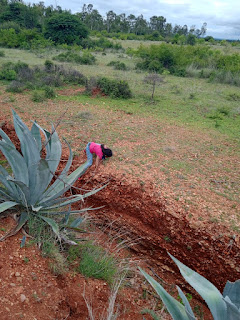JBS is in Tumkur District, Karnataka. As per Deepak Sarmah's "Dry Deciduous Forests of Karnataka" Tumkur, most of it is dry, and a mix of scrub and thorn forests, mainly due to continuous and vast anthropogenic pressures on the land (agriculture, overgrazing, logging etc).
See how brown, dry and caked everything around looks?
Regardless, the drive to JBS is beautiful. Don't follow Google Maps after a point, since it will lead you astray. Instead, rely on the locals to tell you where to go. We drove around for almost an whole extra hour before realizing this.
The day was overcast. Clouds broke upon each other like waves on a turbulent sea shore. It kept drizzling on and off. The wind was brisk but not cold. And from JBS we could see over miles and miles of uninterrupted rolling landscapes dotted with shrubs, short trees and grass. Since JBS is literally in the middle of nowhere, it also happens to be one of the ONLY spots in India where one does not hear the sound of any traffic.
Here are some pics of the landscape:
 .
. 
 .
. 
Entrance to JBS:
 .
. 
We reached there only by afternoon (by all online accounts, the best time to get there is 6-8am or 5-7pm). So we were mentally ready not to see any blackbuck, but to enjoy ourselves anyway.
We saw insects:


This is a yellow pansy butterfly. Pretty, no? Pic on right from Wiki Commons
We saw blackbuck footprints:
We climbed into and out of ditches
And miraculously, also came across blackbuck!
Spot the blackbuck (which is not actually black... these are females which are beige)

Birds we saw at JBS:
a) Peacocks
b) Egrets
c) Laughing dove
d) Large grey babblers (a noisy bunch... when they all call out, they sound like witches cackling)
e) A shrike which I originally thought was a Great Grey Shrike, but now believe must be a Southern Grey Shrike, after comparing the distribution patterns. The Great Grey is a vagrant in India, whereas the Southern Shrike is widespread through much of peninsular India. Size wise they are about the same (24cm vs 25cm), and they are very similar in coloring and behaviour.

The Southern Grey Shrike (https://www.flickr.com/photos/42244964@N03/5360119920)

The Large Grey Babbler (Wiki Commons)
What I would like to do at JBS in the future:
There were multiple birds that I could not recognize (including my old nemesis, the Indian Robin). Additionally, this was the first time I took a slightly more scientific view of butterflies (cataloging them, taking pictures, keeping a record of the ones seen).
What I would like to do is to take a survey of the birds and butterflies seen in the sanctuary over time.
I also wonder if it would be possible for me to be able to count the number of Blackbucks seen there over time. I don't have the training or the equipment to do an accurate count, but would it be possible to maybe track their numbers using footprints as a surrogate? Can one differentiate between male and females using footprints?
These are some questions I would like to answer.







 .
. 






 .
. 



No comments:
Post a Comment